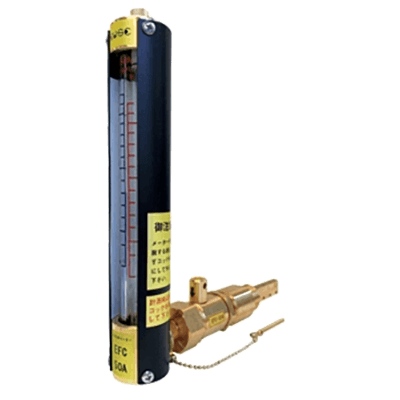What Is an Instantaneous Flow Meter?

An instantaneous flow meter is a meter that indicates the amount of fluid flowing through a pipe instantaneously.
It mainly refers to a meter that indicates a value in the field.
Uses of Instantaneous Flow Meters
Instantaneous flow meters are mainly used in industry, and in production.
Specific Uses of instantaneous flow meters are as follows:
- Performance testing of pumps, engines, etc.
- Flow monitoring of lubricating oil, cooling water, etc.
- Flow monitoring of metering pumps in exhaust gas analyzers
- Brine flow monitoring in refrigeration equipment
- Draft monitoring of local exhaust systems
- Flow monitoring of various types of centralized air conditioners in high-rise buildings
If a flow meter with an electric contact is selected, it is also possible to issue an upper and lower limit alarm for the fluid flow rate in the piping.
Principle of Instantaneous Flow Meters
Pitot tube flow meters and float meters are often used as instantaneous flow meters.
1. Pitot Tube Flow Meter
A Pitot tube flow meter is a type of differential pressure flow meter. A cylindrical tube called a pitot tube is inserted parallel to the fluid flow surface for measurement. The pitot tube has measurement holes on the fluid flow surface and its opposite side, and the differential pressure between the two holes is measured and converted to the flow rate.
The advantages of the pitot tube flow meter are low-pressure drop and high accuracy. It is also suitable for flow measurement of large-diameter piping. However, periodic cleaning is required because clogging of the measurement hole may occur. It is not suitable for fluids containing solids.
2. Float Type Flow Meter
The float-type flow meter is a flow meter with a float enclosed in a graduated glass tube. When fluid flows into the glass tube, the float floats and indicates the flow rate. While the structure of the meter is simple and inexpensive, the high-pressure drop makes it unsuitable for large-diameter piping. Therefore, it is used in relatively small-scale systems.
Types of Instantaneous Flow Meters
Various types of instantaneous flow meters are available in addition to the pitot tube type and float type.
The following are examples of instantaneous flow meters:
1. Positive Displacement Flow Meter
A positive displacement flow meter is a flow meter with gears installed in the fluid flow path. The flow rate is indicated by moving the gears as the fluid flows through the channel. While the accuracy is high, there is a disadvantage of high-pressure loss. Also, if the gears become stuck, the fluid will not flow.
Because of this characteristic, they are often used as transaction meters, such as gas meters and fuel oil meters. Although both integrated flow measurement and instantaneous flow measurement are possible, they are most often used for integrated flow measurement.
2. Electromagnetic Flow Meter
This is a flow meter that converts the electromotive force generated by the electrons in the fluid as it flows into a flow rate by measuring the electromotive force. Since the meter contains electronics for measurement, it requires a power supply. However, some products may have a built-in battery.
There is almost no pressure loss and the flow of fluid is not disturbed. However, due to its measurement principle, it cannot measure the flow rate of non-conductive fluids. This flow meter is capable of both totalized flow measurement and instantaneous flow meter measurement.
3. Ultrasonic Flow Meter
Ultrasonic flowmeters generate ultrasonic waves from outside the piping, receive them at a receiver separated from the fluid, and convert them to flow rate by measuring changes in frequency and arrival time. Due to its measurement principle, a power supply for generating ultrasonic waves is required.
While measurement is possible without pressure loss, it becomes impossible if air bubbles are mixed in the fluid. Although both integrated flow measurement and instantaneous flow measurement are possible, instantaneous flow measurement is most commonly used.
Other Information on Instantaneous Flow Meters
1. Relationship Between Flow Rate and Flow Meter
Flow rate is the volume or mass of fluid flowing in unit time. The measuring instrument that measures the flow rate is called a flow meter. There are two types of flow meters: instantaneous flow meters and totalized flow meters, and they are used in different ways depending on the management method.
2. Difference Between Instantaneous Flow Rate and Totalized Flow Rate
There are two types of flow rates: instantaneous flow rate and totalized flow rate.
Instantaneous Flow Control
Instantaneous flow control is used to measure the volume or mass of fluid passing through a pipe in a unit of time. The instantaneous flow rate is expressed as a value per unit of time. For example, if 10L flow per minute, the instantaneous flow rate is 10L/min.
Totalized Flow Rate
The totalized flow rate is used to measure the volume or mass of fluid passing through a pipe and is the cumulative value of the flow from the start to the end of the measurement. It is measured as the cumulative value from the start to the end of the measurement and is often expressed in terms of volume, such as 10L because it refers to the flow rate over a certain period of time.